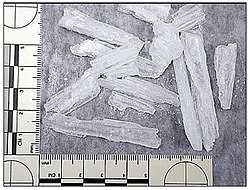| This article's factual accuracy is disputed. Relevant discussion may be found on the talk page. Please help to ensure that disputed statements are reliably sourced. (June 2024) (Learn how and when to remove this message) |

| |

| |
| Names | |
|---|---|
| Preferred IUPAC name N-Benzylpropan-2-amine | |
| Other names
N-(Phenylmethyl)propan-2-amine Isopropylbenzylamine | |
| Identifiers | |
| CAS Number | |
| 3D model (JSmol) | |
| ChemSpider | |
| ECHA InfoCard | 100.002.789 |
| PubChem CID | |
| UNII | |
| CompTox Dashboard (EPA) | |
InChI
| |
SMILES
| |
| Properties | |
| Chemical formula | C10H15N |
| Molar mass | 149.237 g·mol |
| Pharmacology | |
| Legal status |
|
| Except where otherwise noted, data are given for materials in their standard state (at 25 °C , 100 kPa).
| |
N-isopropylbenzylamine is a compound that has appeared in chemical literature often playing an intermediary role in applications of experimental synthesis and novel organic transformations. Despite having limited documented uses, it is most well known for having previously come to the attention of the DEA due to being used by illicit methamphetamine manufacturers as a diluent of or substitute for methamphetamine, with many recorded sightings occurring in the years 2007–2008. It not known to be a controlled substance in any other jurisdiction. Isopropylbenzylamine is not thought to have any stimulant effects in its own right, though anecdotal reports suggest that it may be associated with side effects such as headaches and confusion which are not typically associated with methamphetamine itself. The toxicity of N-isopropylbenzylamine has been studied as of 2022 and it has been found to produces toxicity via increasing nitric oxide in vitro. In this study, in vitro toxicity of N-isopropylbenzylamine and its toxicity-related targets were investigated in SN4741, SH-SY5Y or PC12 cell lines that model neurons. The study sounds an alarm for methamphetamine abusers and warns of the dangerousness of N-isopropylbenzylamine for public health.

References
- Anvisa (24 July 2023). "RDC Nº 804 - Listas de Substâncias Entorpecentes, Psicotrópicas, Precursoras e Outras sob Controle Especial" [Collegiate Board Resolution No. 804 - Lists of Narcotic, Psychotropic, Precursor, and Other Substances under Special Control] (in Brazilian Portuguese). Diário Oficial da União (published 25 July 2023). Archived from the original on 27 August 2023. Retrieved 27 August 2023.
- Xu, Peng; Li, Haijie; Qiu, Qiyang; Xiao, Xiao; Qiu, Yi; Li, Xiangyu; Wang, Youmei; Zhou, Wenhua; Shen, Haowei; Cui, Wei (1 October 2022). "N-isopropylbenzylamine, a methamphetamine mimics, produces toxicity via increasing nitric oxide in vitro". Toxicology. 480: 153337. doi:10.1016/j.tox.2022.153337. PMID 36162621. S2CID 252500676.